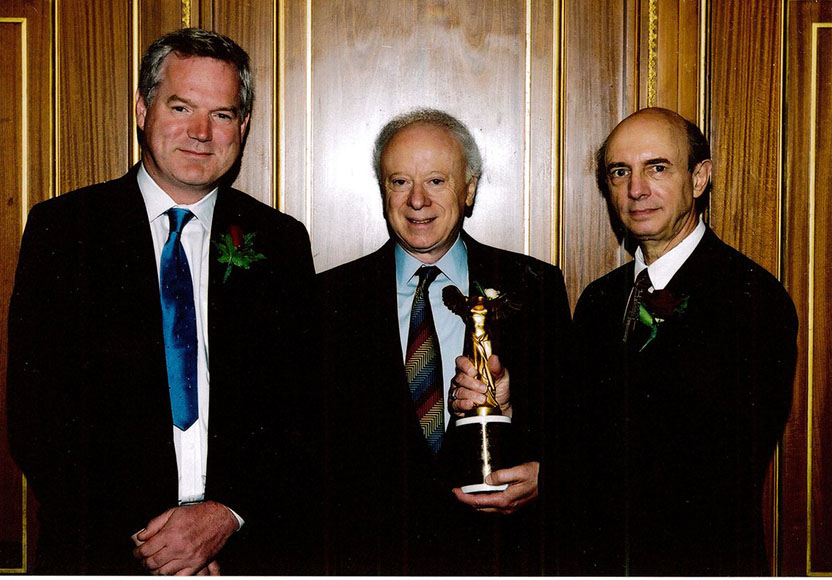Cleaning up the blood supply
In the 1960s, a blood transfusion was a risky prospect. A substantial number of people who received blood subsequently succumbed to hepatitis. Alter and his colleagues at the NIH started conducting prospective studies, with the goals of both rooting out the causes of transfusion-associated hepatitis and testing interventions that might reduce disease transmission.
Researchers enrolled patients who were undergoing open-heart surgery. These individuals received a substantial amount of blood, but didn’t suffer from immune problems or other conditions that might predispose them to infectious diseases. The investigators collected blood before surgery, and then afterward at periodic intervals. They also assembled donor samples, when available.
By measuring the concentrations of an enzyme called alanine aminotransferase (ALT) that the liver produces when inflamed, the scientists could detect early indications of disease. This key test for hepatitis revealed that the illness was striking about 30 percent of people who were receiving transfusions.
Alter and his colleagues traced most of the bad blood to commercial sources. The researchers showed that virtually all the hepatitis occurred in people who had received at least one unit of blood from paid donors. Volunteer blood, in contrast, transmitted very little disease. Furthermore, they showed that excluding commercial blood decreased the risk of transfusion-associated hepatitis.
Earlier, Alter had participated in the discovery of the hepatitis B virus. This breakthrough led to tests to detect it, tools that allowed Alter’s team to search for this virus in blood. Using the stored samples, his group showed that hepatitis B virus in blood increased the risk of transfusion-associated hepatitis.
As a result of these and other findings, the US changed to an all-volunteer blood donation system and instituted hepatitis B virus testing by the early 1970s. Hepatitis rates plunged to 10 percent.
A mysterious villain
Despite these innovations, a significant risk for transfusion-associated hepatitis lingered. By this time, hepatitis A virus had been discovered. In collaboration with Robert Purcell and Stephen Feinstone at the NIH, Alter showed that not a single one of 22 transfusion-associated non-B hepatitis cases was related to the hepatitis A virus, a number that was subsequently expanded to well over 100 by work from investigators at other institutions. The researchers concluded that another culprit was triggering the majority of disease. In the mid-1970s, they called illness of this sort “non-A, non-B hepatitis” (NANBH) without knowing the type or number of agents that sparked it.
In collaboration with Purcell, Alter injected samples from NANBH patients into chimpanzees, and showed that the animals came down with hepatitis. Independently, Daniel Bradley’s group at the Centers for Disease Control and several other labs performed similar experiments and drew the same conclusions. These results proved that a transmissible agent (presumably a virus or bacterium) provoked NANBH hepatitis and that chimpanzees could serve as an animal model for the disease.
Next, the researchers wanted to pin down the troublemaking blood contaminant. Using the samples that infected chimpanzees as a source for the NANBH agent, the Alter team attempted to devise a procedure that would distinguish individuals who carried the infectious material from those who didn’t. The researchers hoped that they could concoct a simple serologic test with which to screen the blood supply — as had been done successfully for many other germs. They employed every conventional technique designed to detect harmful microbes or the body’s immune response to them. All attempts to identify proteins from the presumptive NANBH infectious agent or the host’s antibodies to such proteins failed. Presumably, the concentration of these proteins in blood was too low to detect.
In the meantime, both the Alter-Purcell team and Bradley’s group were characterizing the agent. By filtering blood through different-sized sieves, they determined its size, which suggested it was a virus. By subjecting it to various chemicals and determining which ones foiled its ability to infect chimpanzees, they found out that it was surrounded by a lipid envelope. Thus, even before they saw it, isolated it, or knew exactly what it was, scientists had generated information about its physical and chemical structure.
Alter was also studying NANBH as a disease. Because it tended to produce mild symptoms of liver inflammation, many doctors doubted its clinical significance. Alter showed that about 20 percent of infected people eventually developed cirrhosis, indicating that NANBH was indeed a serious illness. Between 1975 and 1987, NANBH thus began to be recognized as a significant form of hepatitis, and many laboratories joined the efforts to snare the causative agent.
Alter had compiled a collection of blood from NANBH patients and chimpanzees, from patients with other liver problems, and from healthy individuals. He organized these into a series of coded samples, for which only he knew the key. Between 1978 and 1986 about 20 different labs requested the panel to test whether they had discovered the NANBH virus. None broke the code.
The power of molecular biology
In 1982, Houghton’s laboratory at the Chiron Corporation launched a hunt for the NANBH agent. Rather than stalking the elusive proteins and antibodies associated with the presumptive virus, they aimed instead at the infectious agent’s genetic material. By this time, modern molecular biology techniques were flourishing, and included cloning methods to isolate and detect the DNA or RNA that would encode any virus’s machinery. However, because the NANBH germ was so rare, and because no one had uncovered a distinctive molecular tag, the project was similar to searching for a needle in a haystack without the ability to see or feel the needle.
Using infected chimpanzee tissue provided by Bradley, the group sorted through tens of millions of pieces of genetic material, looking for a segment that was present in infected, but not uninfected, individuals. Provocative results emerged numerous times, but in each case, the piece of genetic material proved to arise from a source other than the NANBH agent. Many other strategies also failed to produce anything with the appropriate properties.
In 1985, Houghton and his Chiron colleagues Qui-Lim Choo and George Kuo embarked on a risky approach: they attempted to identify DNA or RNA that encoded viral proteins that would bind to antibodies assumed to be present in NANBH-infected chimpanzee and patient sera. This venture represented a scientific fishing expedition in which the researchers weren’t sure they had either fish or bait. As a source of virus, they used infectious chimpanzee blood and liver — even though they couldn’t directly detect virus in those samples. For bait, they used blood from chimpanzees and patients infected with NANBH, guessing that it contained antibodies that recognized viral proteins — even though no one had evidence for such antibodies. It was unclear if such a ‘blind’ approach would succeed in identifying an infectious agent whose properties were largely unknown.
They extracted RNA and DNA from the chimpanzee samples and made DNA copies of it, which they cut into pieces expected to encode parts of proteins. Then they inserted these bits of genetic material into bacteria and forced the bacteria to churn out large amounts of the corresponding proteins. The researchers sought bacteria that produced protein that bound antibody from infected, but not uninfected, people. In a technical tour de force, they screened tens of millions of bacteria in two years. Finally — in one bacterium — they hooked their potential quarry.
Next, they had to figure out whether this piece of protein represented the virus they sought, or if it was another false lead. Serum from many different NANBH patients grabbed this protein, while that from uninfected individuals slid off. The DNA that encoded the protein bound to a large RNA molecule in infected material, but not in control tissue. Furthermore, the DNA did not reside in the host’s genome. These results strengthened the hypothesis that the protein they had identified came from the viral culprit, and not from the host. Furthermore, treating the infectious samples with enzymes that destroyed RNA obliterated the positive result, while procedures that destroyed DNA left it intact. This observation indicated that the viral genome was made of RNA.
Using the small nucleic acid handle that they had isolated, the researchers plucked out other pieces of the viral RNA. With these, they produced different viral proteins in bacteria and yeast, and used them to capture antibodies from humans and chimpanzees infected with NANBH. They detected binding only to blood from NANBH sources, not to blood from individuals infected with hepatitis A or hepatitis B. These findings convinced the researchers that they had achieved their goal.
Shortly afterward, they asked Alter to send the panel of samples that had stumped everyone so far. Using their new test, they broke the code.
The Chiron team also collected blood from all over the globe and showed that the new virus, which they named hepatitis C virus, was associated with NANBH worldwide. The researchers could identify most cases of disease, indicating that hepatitis C virus was the most common cause of NANBH.
A collaborative study between Alter and the Chiron team showed that transfusion recipients who later acquired NANBH also developed an antibody response to hepatitis C virus. Furthermore, every NANBH patient had at least one donor sample that contained the virus. This meant not only that the new virus was the most prevalent source of NANBH, but also that the test could identify infected donors. The Chiron team reached the same conclusions in collaboration with groups from Japan and Europe. These observations established that the disease arose from a single agent, which they had now pinned down.
With their new and ambitious virus hunting method, the Chiron team had shown for the first time that it was possible to discover a clinically important agent that had not been grown in the lab, microscopically visualized, or identified by even the most sophisticated serologic technique. Because scientists may apply this approach to other diseases that are caused by an unknown infectious agent, the group’s pioneering scheme might someday prove to be as important as the discovery of the hepatitis C virus itself.
Cutting the risk to zero
While the Chiron experiments were progressing in the middle and late 1980s, Alter’s team had shown that an antibody that bound to a second hepatitis B protein could serve as a substitute marker to detect NANBH carriers. He had reasoned that people who engage in high-risk behaviors, such as certain sexual practices and drug use, would carry multiple viruses, and he was right. The US adopted the improved hepatitis B test for routine donor screening in 1987, and the ongoing NIH prospective study showed that this test — plus intensified questioning about high-risk behavior — reduced the hepatitis incidence rate to four percent in 1989.
By that time, Chiron had discovered the hepatitis C virus and proceeded to devise a test for measuring antibody to this agent. This diagnostic tool — licensed and implemented in 1990 — identified two-thirds of blood donors with NANBH, and decreased the risk of transfusion-associated hepatitis to about 1.5 percent by 1992. Because the technique relies on antibodies to a particular viral protein in a person’s blood, it depends on an individual’s ability to produce this immune response, which takes time and can vary. Subsequently, improved tests that detect other hepatitis C virus proteins closed the window on the cases that were slipping through. Between 1992 and 1997, Alter followed 650 blood recipients and didn’t find a single case of hepatitis C. Hepatitis incidence had declined to 0.15 percent, a 200-fold reduction from the 30 percent rate observed in 1970.
Currently, the blood supply carries a risk for transfusion-associated hepatitis of between 1:100,000 and 1:200,000. Scientists believe that the reason it hasn’t hit zero is that a person’s immune system takes a few weeks to produce antibody in response to the virus. During that time, donors can transmit the disease, yet test negative. To solve this residual problem, both Chiron working with GenProbe, and Roche Diagnostics working independently have developed tests that detect viral nucleic acid, which appears in the blood as soon as the virus infects. Blood banks are currently evaluating these techniques, and the tests are likely to enter standard use in 2001. Scientists hope that this latest innovation will fully eradicate hepatitis C from the blood supply.
by Evelyn Strauss
Key publications of Harvey Alter
Blumberg, B.S., Alter, H.J., and Visnich, S.A. (1965). A “new” antigen in leukemia sera. JAMA. 191, 541–546.
Alter, H.J., Holland, P.V., Purcell, R.H., Lander, J.J., Feinstone, S.M., Morrow, A.G., and Schmidt, P.J. (1972). Post-transfusion hepatitis after exclusion of the commercial and hepatitis B antigen positive donor. Ann. Int. Med. 77, 691–699.
Alter, H.J., Purcell, R.H., Shih, J.W., Melpolder, J.C., Houghton, M., Choo, Q.L., and Kou, G. (1989). Detection of antibody to hepatitis C virus in prospectively followed transfusion recipients with acute and chronic non-A, non-B hepatitis. N. Engl. J. Med. 321, 1494–1500.
Alter, H.J., Epstein, J.S., Swenson, S., Van Raden, M.J., Ward, J.W., Kaslow, R.A., Menitove, J.E., Klein, H.G., Sandler, S.G., Sayers, M.H., Hewlett, I.K., and Chernoff, A.I. (1990). HIV-antigen study group. Prevalence of human immunodeficiency virus type 1 (HIV-1) p24 antigen in US blood donors: assessment of efficacy for blood donor screening. N. Eng. J. Med. 323, 1312–1317.
Conry-Cantilena, C., VanRaden, M., Gibble, J., Melpolder, J.C., Shakil, A.O., Viladomiu, L., Cheung, L., DiBisceglie, A., Hoofnagle, J., Shih, J., Kaslow, R., Ness, P., and Alter, H.J. (1996). Routes of infection, viremia, and liver disease in blood donors found to have hepatitis C virus infection. N. Engl. J. Med. 334, 1691–1696.
Farci, P., Shimoda, A., Coiana, A., Diaz, G., Peddis, G., Melpolder, J.C., Strazzera, A., Chien, D.Y., Munoz, S.J., Balestrieri, A., Purcell, R.H., and Alter, H.J. (2000). The outcome of acute hepatitis C predicted by the evolution of the viral quasispecies. Science. (in press in 2000)



